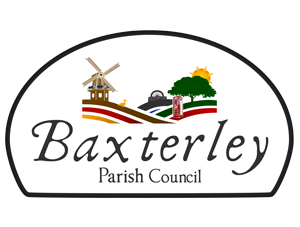 This map shows how the Village used to be centered around Baxterley ChurchThe historic Parish of Baxterley is an agricultural area of remarkable natural beauty which is increasingly popular with visitors of all kinds.
This map shows how the Village used to be centered around Baxterley ChurchThe historic Parish of Baxterley is an agricultural area of remarkable natural beauty which is increasingly popular with visitors of all kinds.
Although not in the Doomsday Book, Baxterley Village seems to have been in existence since at least Saxon times when North Warwickshire was part of the Forest of Arden.
The name of Baxterley is a combination of the Old English word for ‘baker’ which is ‘baecestre’, and the Saxon word ‘leah’ which means ‘clearing’ and until the 1980s an old bake-house remained at Ivy Bank behind the now closed village shop. Earlier spellings are Basterleia 1170, Baxterledge 1221, Bagterleye 1232, and Bakestereley in 1293.
Other spellings include, Basterleia 1170, Baxterledge 1221, Bagterleye 1232, and Bakestereley in 1293.
The Manor of Baxterley was established in Medieval times by the Normans when village life would have centered around Baxterley Church and the nearby Manor House which was Baxterley Hall. Ownership of the manor was originaly held in two ‘moieties’ or equal parts. One part was held by the Earl of Warwick and the other, most probably, by the Earl of Derby who in the 12th century is thought to have given Baxterley Church to Merevale abbey.
The remainder of this second moiety then seems to have lost its manorial status and was then taken over by the Abbey also. In 1541. after the Disolution of the Merivale monastry by Henry VIII in 1538, the property of the Abbey was granted to Sir Walter Devereaux.
This appears to have brought the two moieties together as the Devereaux family had inherited the other moiety which was originally granted to the Earl of Warwick. Around 1600 the land was sold to the individual freeholders ( who rented different areas of the manor ) but by the mid 18th century the manor lands appear to have been re-united again under the ownership of the Hall family. Baxterely Hall Estate was subsequently run by a number of different families until the mid 19th century when it was sold to William Dugdale from the neighbouring Mervale and Blyth Estate who bought the estate in 1848 and demolished the Hall 1849
 Baxterley Hall
Baxterley Hall
The only known image of the once great Baxterley Hall drawn by its last known inhabitant Lady Kinatore in 1840 ” .. from the bottom of the park …”The new owners operated coal mines and expanded their activities in 1851 by sinking two mine shafts on Baxterley Greater Common, which had been part of the Baxterley Hall Estate. This gradually shifted the social centre of the village as more and more men worked at the colliery and in 1868 Baxterley Greater Common and Baxterley Lesser Common, at Wigston Hill, were both fenced off under the last of the Warwickshire Enclosure Acts.
